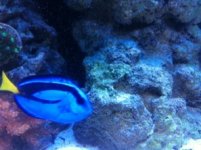There is a huge database on parasites/diseases on the board, use it.
http://www.manhattanreefs.com/forum/pests/
http://www.manhattanreefs.com/forum/pests/99511-black-ich-black-spot-turbellarian-infection.html
What causes black "Ich"??
Black "Ich" is caused by one or more genus of flatworm (Phylum Platyhelminthes) belonging to the class Turbellaria. Most cases of black "Ich" appear to be caused by
Paravortex sp. (Noga, 2000) however, Cannon and Lester (1988) found turbellaria of the genus
Ichthyophaga on a parrotfish (
Scarus ribulatus) in addition to
Paravortex sp. on du
sky flathead (
Platycephalus fuscus).
The life cycle of Paravortex sp.
Noga (2000) describes the life cycle of the parasite as follows. Juvenile turbellaria attach to the host fish and grow from around 77 to 450 ?m. After around 6 days, they drop off the host and fall to the substrate where their eggs and larvae develop internally for 3 to 4 days. The adult's body wall ruptures and up to 160 juveniles escape and can immediately infect any susceptible hosts. The life cycle takes around 10 days at 24.5?C (76?F).
The signs of black "Ich"
The most obvious sign of black "Ich" are numerous dark spots covering the body of the infected fish.
Treatment for black "Ich"
Formalin baths are used for the treatment of parasitic turbellaria. The formalin baths should be repeated every three days until there are no signs of infection. With this regime subsequent baths will kill parasites that were not on the fish during previous baths. Some hobbyists have had success with the use of freshwater dips. These should also be repeated every three days, you also need to make sure that the water is adjust for temperature and Ph.
Formalin Baths
Formalin baths for 30 to 60 minutes, or as long as the fish can take it. The bath water should be matched closely with the tank water and probably the best way is to take water from the tank and place it in a bucket, add the formalin, mix well, and treat the fish. Add an airstone to the bucket to ensure good aeration (and then toss the airstone away). After the dip is completed, dilute the dip water with tap water and discard it, also discard the bucket too. Have a second bucket of tank water ready to transfer the fish to when the treatment is complete or if the fish starts to show signs of stress. The second bucket allows the fish to be "rinsed" before it is placed back into the tank, as you don't want to get formalin in your display tank. If the fish appears to be having trouble breathing, more than before the bath started, remove it at once.
The dosage should be for each gallon of water, around 0.6 ML of formalin should be added to get the desired dosage. The warmer your water, the less formalin that should be used as both formalin and increasing temperature reduces the oxygen saturation of the water. You should use formalin 37.5%.
Formalin is very dangerous and care should be taken when using it. Gloves and eye wear should be used, and disposed of when done. If you do get any on yourself it should be rinse off right away.
Turbellarian Infection
This infection is seen most often on Yellow tangs, partially because the black spots are so easily visible against a yellow background, but it effects many other fish. Usually, only one or two fish are affected at a time. Some common names are Tang Disease and Black Ich.
Symptoms to look for are as follow:
? Black spots on the skin with a pepper-like appearance
? Scratching
? Faded colors
? Hyperactivity
? Decreased appetite
? Lethargy in advanced stages
? Increased respiration in advanced stages
? Skin hemorrhaging in late stages
? Secondary bacterial infection, which may include cloudy eyes and fin rot in late stages






